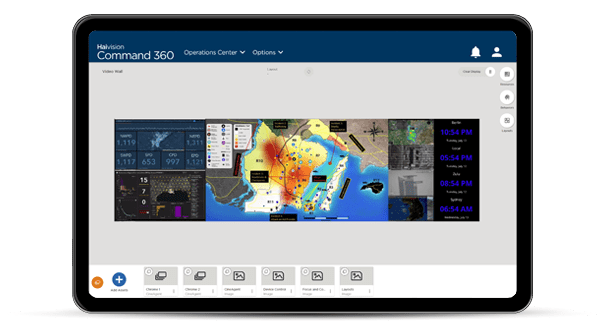A Network Operations Center (NOC) provides core management of computer, telecommunications, and/or satellite networks. NOCs track network operations and security. It enables operators to perform preventative and corrective maintenance when necessary. Many discrete, highly technical activities take place under this broad umbrella but one of the primary goals of any NOC is to eliminate system downtime. A high-performance visual collaboration platform is the ‘core within the core,’ providing cohesive monitoring of network operations.
The Real Cost of Downtime
The old cliche time is money persists because it conveys an indisputable truth. The 18th century coiners of this very small phrase could have never anticipated its vast modern implications. In our extremely device-oriented, data-driven, technologically integrated world, even momentary downtime instantly translates to direct and indirect revenue loss. Projections vary from source to source, but the outlook is always bleak. The total cost per minute of unplanned system outages ranges from an average of $5,600 to more than $17,000 depending on the size and nature of an organization. Assuming the low end of that assessment, an organization incurs over $300,000 in losses for one hour of network or application outage.
NOC managers must anticipate impacts across revenue, productivity, and recovery efforts. Losses can be calculated by capturing the duration of an outage against the number of employees, salaries, weekly revenue, and utilization percentage of employee productivity. Intangible costs, on the other hand, include immeasurable external factors which are far more difficult to quantify. A major outage event extends beyond internal operations, potentially influencing public perception among customers, stakeholders, and partners. Mitigating, or ideally preventing lost revenue and protecting brand reputation requires bold, forward-thinking action by NOC leadership.
The Proactive NOC
Haivision recently had the pleasure of working with Akamai Technologies, Inc., a global content delivery network, cloud services, and cybersecurity provider. As an industry leader, Akamai has taken a strong, proactive approach to provide outstanding network services to their customers who comprise 15-30% of worldwide web traffic.
To refresh and upgrade their existing facilities, Akamai planned a single, large command and control room which would house both their Broadcast Operations Command Center (BOCC) and a Network Operations Command Center (NOCC). The combined space would incorporate new technologies to heighten network reliability and performance and ultimately reduce downtime. The NOCC needed to be streamlined for optimal workflow as well as compelling for the customer tour experience. Operators in the BOCC focused on monitoring raw content streams and playback on a collection of the world’s most used media players.
Advanced Technologies
Constant Technologies, a well-established video wall and technology integrator, had worked with both Akamai and Haivision in the past. After initially assessing Akamai’s control room space, Constant brought Haivision into the project to deliver a secure, reliable solution tailored to Akamai’s technical and logistic design needs. An impressive 25×3 panel video wall featured a small air gap with a sliding glass partition used to divide the spaces and content when necessary. The practical, yet aesthetically pleasing space met operator needs while providing a secure space for ‘wow-factor’ tours.
The new visual collaboration platform the team implemented also provided multiple avenues to ensure system redundancy and reliability. First, CineNet content management software gives users automatic and manual backup capability. Next, because the system incorporates two Alpha FX Elite video processors, operators can create mirrored displays within CineNet for a hot back-up in the event of a system failure. Finally, two Site Managers complement the system to add an extra layer of redundancy if either Alpha FX processor becomes unavailable. Site Managers also create a secure gateway to protect the system’s core processors against external threats which could result in costly downtime.
Innovative Solutions
In addition to CineNet, the Alpha FX Elite processors, and a suite of CineLink 4k encoders and decoders, the Akamai NOCC presented the perfect environment to develop and deploy Haivision’s CineAgent server. Haivision engineered the CineAgent design while collaborating with Constant and collecting customer insight along the way. For example, touch-screen controls were added to supplement standard KVM controls at Akamai’s request. The CineAgent facilitated Akamai’s massive web and local application streaming needs without bogging down the network or tying up individual operator workstations.
“CineMassive [Haivision MCS] realized that in addition to superior video processors and content management software, they would need to create new technology to give Akamai the capabilities they desired.”
The previous video wall system, employed in their legacy control room, faced multiple issues and limitations. Now, users in both the BOCC and NOCC have greater flexibility and control of their content thanks to CineNet. Operators can customize layouts, content types, automatic behaviors, and presentation materials quickly, easily, and without in-depth training or technical experience. With the easy-to-use interface, built-in hardware redundancies, system backups, and brand new CineAgent servers, Akamai’s BOCC and NOCC significantly mitigate the threat of costly downtime.
To learn more about this project, please see our Akamai Operations Command Center Case Study. To explore what Haivision can do for your network operations, contact us to speak with one of our visual collaboration experts.
